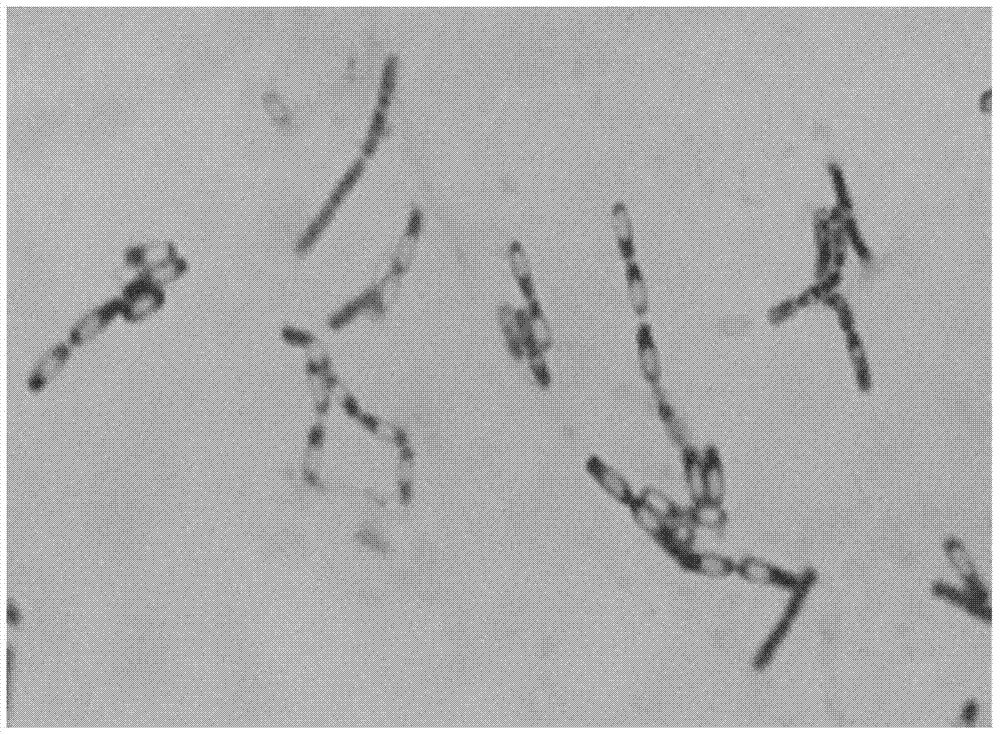Method for producing flocculant by culturing a strain of bacillus and composite wastewater
The technology of bacillus and bacillus is applied in the field of co-cultivation of bacillus flocculants in monosodium glutamate wastewater and soybean product wastewater, which can solve the problems of high preparation cost, low flocculation efficiency, unclear metabolic pathway and regulation mechanism, etc., and achieves improved dehydration. performance effect
- Summary
- Abstract
- Description
- Claims
- Application Information
AI Technical Summary
Problems solved by technology
Method used
Image
Examples
preparation example Construction
[0086] The preparation method of flocculant of the present invention, described method comprises the following steps:
[0087](a) Inoculate the bacillus with the preservation number CGMCC NO.9143 in the LB medium, and cultivate it for 18-24 hours to obtain the primary seed liquid;
[0088] (b) cultivating the primary seed liquid obtained in step (a) for 18-24h in the seed medium to obtain the secondary seed liquid;
[0089] (c) inoculating the secondary seed solution obtained in step (b) into a fermentation medium and culturing to obtain the flocculant.
[0090] In another preferred example, the flocculant is polysaccharide.
[0091] In another preferred embodiment, the step (a) is cultivated under the conditions of 35-45° C. and 150-180 rpm.
[0092] In another preferred embodiment, the step (b) is cultivated under the condition of 35-45°C, and the step (c) is cultivated under the condition of 30-50°C (preferably 35-45°C).
[0093] In another preferred example, the bacteri...
Embodiment 1
[0125] Isolation of flocculant producing bacteria
[0126] The sample is the activated sludge collected from Xipian Sewage Treatment Plant in Wenzhou, Zhejiang. Add 1g of activated sludge to 99ml of sterile water and mix it evenly, then dilute it with sterile water to a weight (g) volume (ml) ratio of 10 -4 、10 -5 、10 -6 Three dilutions were spread and inoculated on the LB plate, and after culturing at 35°C for 48 hours, a single colony was picked and streaked on the LB plate to purify until it was a pure culture by microscopic examination, and then transferred to the LB slant after culture. Store at 4°C.
[0127] The isolated pure strains were inoculated into flocculant-producing medium (glucose 20g, K 2 HPO 4 5g, KH 2 PO 4 2g, (NH 4 ) 2 SO 4 0.2g, NaCl 0.1g, urea 0.5g, yeast extract 0.5g, MgSO 4 0.2g, H 2 (21000ml, pH7.5), shake and cultivate at 35°C and 160rpm for 72h, centrifuge at 8000rpm for 10min to obtain the supernatant, measure the flocculation activity of...
Embodiment 2
[0130] Compound mutagenesis of Bacillus sp.WZ01
[0131]Insert the bacterial strain Bacillus sp.WZ01 obtained in Example 1 into a 250ml Erlenmeyer flask equipped with 50ml LB medium, vibrate at 35°C and 150rpm for 24h to activate, then transfer to In a 250ml Erlenmeyer flask with 50ml of LB medium, shake culture at 35°C and 150rpm until logarithmic phase (about 18h). Take 50ml of bacterial liquid and centrifuge at 5000rpm for 10min, wash the bacteria twice with normal saline, and then make 10 8 pcs ml -1 left and right bacterial suspensions. Take 15ml of bacterial suspension in a plate for ultraviolet mutagenesis. The power is 15W UV ultraviolet lamp, the irradiation distance is 20cm, and the irradiation time is 18min. Take 5ml of the bacterial suspension irradiated by ultraviolet light and inoculate it into a 250ml Erlenmeyer flask filled with 50ml of LB medium wrapped in black paper, and shake and cultivate at 40°C and 150rpm for 4-6h.
[0132] Centrifuge the bacterial ...
PUM
 Login to View More
Login to View More Abstract
Description
Claims
Application Information
 Login to View More
Login to View More - R&D
- Intellectual Property
- Life Sciences
- Materials
- Tech Scout
- Unparalleled Data Quality
- Higher Quality Content
- 60% Fewer Hallucinations
Browse by: Latest US Patents, China's latest patents, Technical Efficacy Thesaurus, Application Domain, Technology Topic, Popular Technical Reports.
© 2025 PatSnap. All rights reserved.Legal|Privacy policy|Modern Slavery Act Transparency Statement|Sitemap|About US| Contact US: help@patsnap.com



